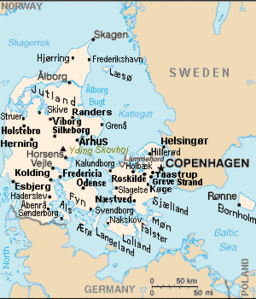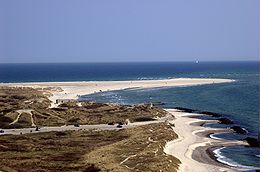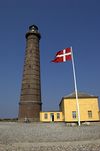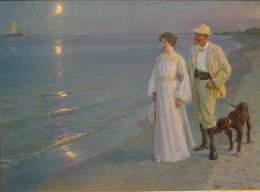Skagen
| Skagen | ||
| Town | ||
|
||
| Country | Denmark | |
|---|---|---|
| Region | Region Nordjylland | |
| Municipality | Frederikshavn municipality | |
| Coordinates | ||
| Population | 8,636 (2010-01-01) | |
| Timezone | CET (UTC+1) | |
| - summer (DST) | CEST (UTC+2) | |
| Postal code | 9990 | |
 Skagen (top center) in Denmark
|
||
Skagen (The Skaw) is a projection of land and a town, with a population of 8,636 (1st January 2010)[1], in Region Nordjylland on the northernmost tip of Vendsyssel-Thy, a part of the Jutland peninsula in northern Denmark. Skagen is located in Frederikshavn municipality.
Contents |
Geography

Skagen takes its name from the region, which projects into the waters between the North Sea and the straits of Denmark. Skagen is considered the boundary between the Skagerrak (named after Skagen) and the Kattegat. At its very tip is a sandy, shifting headland known as Grenen. Here it's possible to experience the sight of waves clashing together from each side of the tip. Danish national road 40 also passes through Skagen.
Skagen stretches out to the northeast surrounded by the following waters:
- to the east is Ålbæk Bay (Ålbæk Bugt) and beyond that the waters of the Kattegat, the strait that separates Denmark from Sweden
- to the west is Tannis Bay (Tannis Bugt) and beyond that the waters of the Skagerrak, the strait that separates Denmark from Norway
Description
The area is extremely picturesque, and distinguished by its low, yellow houses with red tile roofs nestled into the beach areas. The impressive and wild landscape was largely formed by a severe process of desertification that hit the area in the 18th and 19th centuries.
Problems with moving dunes and desertification were brought under control in the latter 19th and early 20th centuries by large-scale plantations of grasses, bushes and fir trees. Two significant migratory dunes remain in the area, including the enormous Råbjerg Mile.
The area continues to be a popular tourist destination visited by many people each year. A highlight of the year is the celebration of Midsummer Eve or St. John's Evening (Sankt Hans Aften) on the beach with blazing bonfire and song.
Skagen is the setting for small but important parts of Jonathan Coe's novels The Rotters Club and The Closed Circle.
History

Always sparsely populated, until recently Skagen has been of interest mainly to mariners. Of the region now known as Skagen, Pliny the Elder says (Book IV.97):
- "Promenturium Cimbrorum excurrens in maria longe paeninsulam efficit quae Tastris appellatur."
- "The promontory of the Cimbri running far out into the seas makes a peninsula, which is called Tastris."
The name Tastris is a hapax legomenon, recorded only once in all of history. Its meaning is not known: it may be the name assigned by the pre-Indo-European Mesolithic culture that once dwelled in the region, or by the subsequent agriculturalists.
Skagen, on the other hand, seems to follow Pliny's description of a projection running out into the "seas" (maria). There is a set of obscure words in modern Germanic languages that seem relevant: English skeg, a projection of a ship's keel, shag, a surface with projections, Swedish skägg (pronounced sheg), "beard". The root remains as yet unidentified.
Once a remote fishing area, it become considerably easier to travel to Skagen after it became connected to the rest of the country via a railroad line in 1890. A paved road followed in the 1940s.
Attractions


The headland at Grenen, the northernmost point of Denmark, is a spectacular setting where two parts of the North Sea, the Kattegat and the Skagerrak, meet. This makes for turbulent seas and strandings — beachings and shipwrecks are common. The frequent shipping losses and the strategic location as the gateway to the Baltic led to Skagen being the site of one of Denmark's earliest lighthouses, the Vippefyr, constructed in the 15th century. A reconstruction of the lighthouse is located to the north of the town of Skagen.
The lighthouse was originally built and funded by the late Medieval Danish state with the proceeds of the "sound dues", and was superseded by the "white lighthouse" or hvidefyr in the 17th century, and then the far taller "grey lighthouse" or gråfyr of the 1850s.
The desertification that hit the area in the 18th and 19th centuries led to the abandonment of the old parish church to the migrating sands — the famous Buried Church (Den tilsandende Kirke). The tower of the church remains protruding from the dunes, as it was left as a sea marker when the church was abandoned at the close of the 18th century.
In central Skagen there is a teddy bear museum called Skagen Bamsemuseum[2]. The teddy bears on display belong to the private collection of the owner Jonna Thygesen.
Skagens Museum
The area is closely associated with the Skagen Painters, a community of artists (artist colony), who flocked to this picturesque, and then unspoiled, area in the late 1800s to escape the city and to record artistically a way of life they realized was soon to disappear.
Skagens Museum was founded in the dining room at Brøndum’s Hotel during October 1908. Chemist, Victor Chr. Klæbel, hotel proprietor, Degn Brøndum, and artists, Michael Ancher, P.S. Krøyer and Laurits Tuxen were elected to form the first board of governors. After P.S. Krøyer’s death in 1909, his house in Skagen Plantation was used as a museum. In 1919, Degn Brøndum donated the hotel’s old garden to Skagens Museum. The building of the museum was commenced in 1926. The new museum was inaugurated during September 1928.
In 1982 the exhibition rooms were extended with an annex drafted by the Royal Surveyor, architect Jacob Blegvad. The same architect also designed the later extension to the museum that was inaugurated in 1989. In 1997 the museum administration moved into the Technical School. Today Skagens Museum has more than 1800 works of art at its disposal.[3]
Famous residents of the town

The Skagen Painters, who enjoyed the reputation of a bohemian lifestyle, encompassed not only painters, but also writers, and other influential people as well. While only a few were fulltime residents of the area, they were often joined by friends, especially during the summer months. Among these notable visitors and residents of the time were writers Holger Drachmann, Georg Brandes, Hans Christian Andersen, and Henrik Pontoppidan, artists Peder Severin Krøyer, Marie Triepcke Krøyer Alfvén, Christian Krohg, Michael Ancher and Anna Ancher, and composers Carl Nielsen and Hugo Alfvén. They were often gathered at the area's Brøndum's Hotel, which is still in operation today.
See also
- Frederikshavn municipality
- Tourism in Denmark
- Skagensbanen
- Grenen
References
- ↑ BEF44: Population 1st January, by urban areas database from Statistics Denmark
- ↑ http://www.skagensbamsemuseum.dk/
- ↑ Skagens Museum
